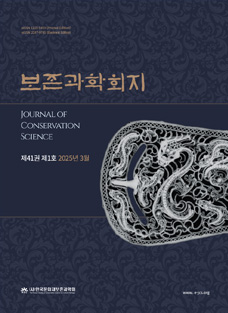Journal of Conservation Science Vol.29 No.3 pp.279-286
한반도에서 출토된 적갈색 유리구슬의 특성 및 유형 분류
Characteristics and Classification of Red Brown Glass Beads Excavated in Korean Peninsula
Abstract
It is characterized and classified as the type of red brown glass beads to compare the chemical composition and manufacturing technique on the 141 samples in 12 sites of the Three Kingdom Period analyzed until now. It can be divided into three types according to the chemical composition of stabilizers(CaO & Al2O3) and soda raw materials(MgO & K2O) on the red brown glass beads except one sample. Type I of high alumina glass is identified as the most common types that is 78.6 % of the distribution ratio at analytical samples and is excavated the most from ruin sites. In contrast, type II, 13.6 % of distribution ratio at analytical samples, is about 5 % CaO and Al2O3, MgO and K2O at around 1.5 % is similar to the composition of plant ash glass. Type III is that the content of CaO is higher than Al2O3 and the content of MgO and K2O is below 1.5 %. It is the same as the composition of natron glass and its share is the lowest as 7.9 %. Of these, type III is divided into two types according to the content of MgO and K2O. It is identified that manufacturing technique of type I and II is drawing and type III is casting method with microscopic investigations. Type II and III is estimated that raw materials is different because is confirmed in the majority of ruins in spite of the fact that distribution ratio is very low. So, red brown glass beads distributed in Korea Peninsula are divided into three types of glass culture.

 E-Submission
E-Submission 
 E-Submission
E-Submission 
![]() Journal Search Engine
Journal Search Engine




 KSC
KSC